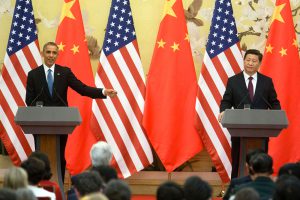As Xi Jinping and Barack Obama met in Washington on Friday, action on climate change looked like one of the few areas where both leaders could make additional progress. The state visit came amid tension about China’s claims in the South China Sea and US allegations that Beijing has orchestrated widespread hacking of US companies. chinadialogue asked experts on China’s energy and climate policy how the US and China could co-operate further.
Pan Jiahua, director of the Centre for Urban Development and Environment at the Chinese Academy of Social Sciences and a member of the National Expert Committee on Climate Change
The China-US joint statement last year showed both political will to cut greenhouse gas emissions and specific commitments. Climate change is a matter of interest for both parties, but it is unlikely we’ll see new climate change topics discussed at this meeting. I think we will see a clearer and stronger expression of expectations for the UN climate talks in Paris in December; further clarification and descriptions of each country’s voluntary contributions; and deepening cooperation on low-carbon cities, local governance and business.
There many areas where China and the US could cooperate. Businesses are the drivers of technological progress, and in the US this is market-led. For example, in the US you can lease your rooftop to a company that will install solar panels on it. China could adopt this approach to develop renewable energy; there’s huge potential there. US local governments have the power to plan development and to set and enforce standards, and US states can pass their own laws. But in China local governments have less autonomy and have to do what central government orders them to do. China’s local governments could learn a lot through cooperation with their counterparts in the US, on planning for low-carbon cities andon transportation.
China and the US now need to strengthen the political will they have demonstrated in order to increase the chances of a deal in Paris, and ensure it is implemented smoothly.
Ray Cheung, former executive director of the US-China Energy Cooperation Program, a consortium of US and Chinese companies that supports bilateral commercial cooperation on climate change
China-US cooperation on carbon emissions requires impetus at the corporate level. I hope to see deeper cooperation on this point. But support and encouragement for companies cutting emissions and saving energy will require systematic planning from both countries, as well asfinancial backing.
Xi Jinping’s delegation includes many business people with deals to discuss. But these are individual projects, not something that has been systematically arranged. How can we make sure projects go ahead and communication increases? The two governments need to come up with a systematic plan: what are the sectors earmarked for cooperation? What is the scope of cooperation – for example in electricity generation, construction materials, coal-to-chemicals? However closer co-operation may likely mean that the development, transfer and sharing of new technologies can be encouraged.
Specific locations for tie-ups in both countries need to be identified. For example, more cooperation between coal-mining areas might be desirable. And any agreement needs to be specific about the technologies involved.
Emissions cuts need to be achieved at the company level, but companies worry about costs and profits – so they need greater encouragement. Currently there isn’t any financial support for companies working together. China and the US could set up a joint fund to facilitate this. There also needs to be policy support, such as simpler and faster approval processes, or tax breaks and loans.
Yu Jie, communications strategist with chinadialogue
Climate change is certain to be on the agenda for Xi’s visit to the US. But we won’t see anything as important as the joint statement that followed the APEC summit last year. However, last year’s statement will provide the foundation for the Intended Nationally Determined Contributions (INDCs) both nations will separately make this year to the UN.
When it comes to the accuracy of Chinese emissions data, an issue that has been brewing since 2009, both parties are likely to try and work out other’s bottom line. Back in 2009, the concept of ‘measurable, reportable, verifiable’ emissions was put forward, which has developed into the language we see in climate talks today: ‘transparent and dependable.’ As Obama is hampered by domestic politics, his administration will need to take into account public opinion and demands back home.
Meanwhile, for China commitments are hampered by incomplete statistics and national security issues related to the data involved. People will be watching to see if and how compromises can be reached.
The meeting is expected to produce position statements on climate change, and concrete cooperation at the corporate level. Prior to the trip, the Chinese media discussed in detail the business people in Xi’s delegation. According to the list of members, there was only one private sector energy company was represented, Xinao Gas. Xinao has been one of the stars of China-US energy cooperation, because it has worked with Duke Energy on photovoltaics and General Electric on distributed energy for data centres and coal-to-gas. Xinao plans to invest $5 billion in the US energy sector over the coming decade.
The Obama administration will be concentrating on its Clean Power Plan. This relies on the powers of the Environmental Protection Agency and is key to achieving the country’s 2030 emissions target. Internationally he is constrained by the fact that Congress will not approve the use of public money to fund climate change mitigation or emissions reductions in developing nations. So the US doesn’t have much diplomatic power to push things forwards atthis year’s international talks. Although the China-US summit is receiving global attention, I’m afraid in the end it is Europe again that will have to provide leadership on climate change.
The host of this year’s climate summit, France, will spare no efforts. It has made a statement of its expectations for the talks and is undertaking shuttle diplomacy. I understand that France’s climate envoy has visited China at least once a month this year. Meanwhile, in the run-up to the China-US summit, talks among senior officials and at the ministerial level have focused on trade and regional conflicts.
Ma Zhong, professor and dean of the Renmin University School of the Environment
Some worry that China will not meet its GHG emissions commitments, but there is no need. China voluntarily made this commitment and wants to make the cuts. There is no likelihood of failure for several reasons.
Firstly, China has admitted that its emissions are highest in the world, almost double those of the US. Its per capita emissions are already higher than in Europe. This trend requires urgent action and China has to respond.
Secondly, China is confident it can make large emissions cuts. Although the country has committed to a carbon peak in 2030, mainstream research bodies are optimistic that it could be earlier. Economic growth has slowed to 7% annually, meaning a big drop in growth in demand for coal. When economic growth was at 10%, coal demand grew by 8% a year. But at 7%, demand for coal demand stays level, and, having peaked in 2013, it fell in 2014 and is continuing to drop.
Alongside the economic slowdown, China is continuing its economic transition. In 2013, the service sector became larger than the industrial sector, with the gap now 6%– the service sector accounting for 48% of the economy, while industry is 42%. That situation is unprecedented in China. If the trend is maintained and service sector growth continues to outstrip that of industry, the 2013 coal consumption figure will be the peak. If coal consumption doesn’t grow, neither will emissions.
So China’s commitments have foundations.In the last three years, renewable energy growth has speeded up. The plan is to see the five main non-fossil sources of energy account for 15% of total generation by 2020. In 2010, that figure stood at 10%, but over the last four years growth has accelerated and now stands at 12.3%.
The economic slowdown and economic transition are leading to slower growth and decreasing emissions. But some, thinking back to the 4 trillion yuan stimulus package of 2008, say China may increase investment to combat that slowdown. That approach is generally unpopular now. Decision-makers aren’t going to use the same method again. And, even if they wanted to, it’s not possible. In 2008, the economy was growing quickly and there was high demand for steel, concrete and power, but that demand no longer exists. China is also not intending to go back to the days of 10% GDP growth – it’ll be happy with 7%.
Barbara Finamore, Senior Attorney and Asia Director at the Natural Resources Defense Council
President Xi’s trip to Washington DC offers a pivotal opportunity for the US and China to build on last November’s breakthrough climate agreement. There are many ways in which the two countries can work together to implement and deepen their commitments. A binding national cap on coal consumption, for example, could help China peak its CO2 emissions earlier and faster, while saving lives and creating jobs.
Scaling up flexible demand side resources like electric vehicles and demand response to support the grid could enable China to get 85 percent of its electricity from renewables by 2050. Working together on mitigation of non-CO2 greenhouse gas emissions would help avoid the acceleration of near-term global warming while reducing China’s serious air pollution. Promoting city-to-city cooperation could help to address major gaps in China’s low-carbon urbanisation drive. In any case, a pledge by the world’s two largest greenhouse gas emitters to take stronger climate action together would not only be a major step forward but would set the stage for other countries to strengthen their level of ambition in the run-up to the Paris negotiations.






